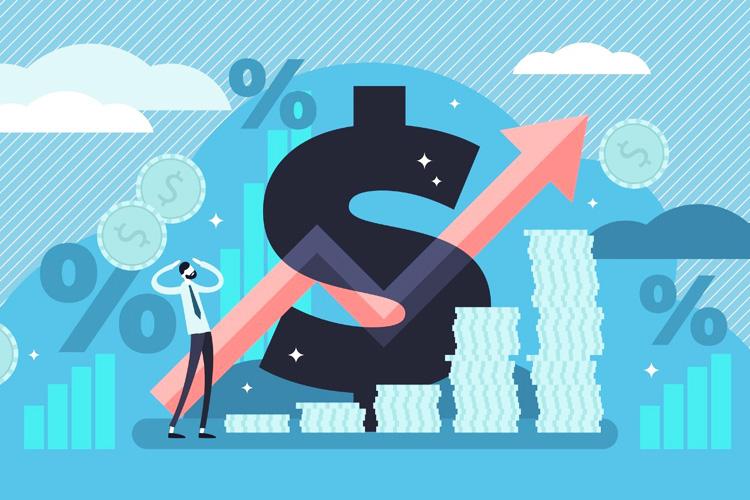
For much of the pandemic, there has been fear about Inflation and what kind of effects it might have once things started to open up. In 2020, we actually witnessed prices go down which is a phenomenon we aren't used to in North America1. Starting in March of 2020, the COVID-19 crisis and the restrictions brought in to deal with it reduced demand for many services. The prices for these services dropped in many cases. We had a major crash in energy prices and these factors led to a slowing of inflation. Between March and May of 2020, the US experienced a very rare occurrence of deflation2. Falling prices in 2020 meant that the base from which annual inflation rates would be calculated in 2021, would be lower. This would then lead to inflation rates appearing higher in 2021 than they may actually be. I'm bringing this up because it's important to discuss why so many Economists and Central Bankers across the globe were not more concerned about rising prices as the economy really opened up. The word "transitory" was used about a million times to explain the situation. I believe that a lot of people thought that we would have a modest amount of inflation but that the 2020/2021 effect would make it look worse than it was. Fiscal policy across the globe injected more and more money into the system even though employment had been coming back strongly in many countries. Both the United States and Canada got back to unemployment numbers as low as before the pandemic started3. The combination of low unemployment, cheap money, major supply issues, and piles of money coming into the system created a situation where prices went up and continued to rise. Many mistakes were made over the last two years and you are now feeling it at the grocery store and when you open up your monthly bills. Central Banks are now aggressively raising rates so you will also be feeling higher costs on any of your Variable Rate Debt.
Interest Rates and Inflation will need to be at the top of mind for the foreseeable future. Certainly, this is not transitory. In Canada, our Inflation Rate is officially at 6.7% which is a number that we haven't seen in decades4. While some other countries like France are at a more manageable 4.5%, very few are anywhere near the 2 to 2.5% rates that we have got accustomed to. We are all hoping that this situation improves but we have to talk about the reality that it could get worse before it gets better. Other countries are dealing with much higher rates than we are. The UK is currently at 7%, Mexico is at 7.45% and the USA is seeing an ugly 8.5% inflation rate. Brazil is sitting at a scary 11.3% rate and Russia, after invading their neighbor, is getting punished with a 16.7% increase in prices4. There is no cap on how high prices can go. I'm not showing you these numbers to scare you; I'm showing you these numbers to illustrate that this is a global phenomenon and a situation that could continue to escalate. Will we hit 8.5% here in Canada? Will we hit 11.3%? We simply don't know but I will urge you to prepare for higher prices as we get further into the year. Remember, investing in Energy, Precious Metals, and other Commodities can help you keep up. That's why we have put these Real Asset Funds in your portfolios!
Another topic of discussion over the last six to twelve months is Growth vs. Value Investing. Growth Stocks can be found in Small, Medium and Large Companies who have the potential to continue growing. Basically, they haven't reached their full potential yet. While some may pay Dividends, many reinvest profits back into their businesses in order to continue focusing on expansion and more growth. Once it is believed that they have reached their full potential, they may fall into the Value category. Value stocks are usually larger, well-established companies. This could include Banks, Insurance Companies and Large Retailers. Value Stocks are thought to be trading below a price which they are actually worth. Many Value Investors will be focused on buying Large Companies who pay healthy Dividends. If you are able to buy them at an attractive price, and sit on the Dividend Payments, it can really pay off in the long run. While there may not be as much upside on the Share Price of a Value Stock, the income stream can be attractive and there can be room for some price appreciation. 2020 and much of 2021 was all about Growth Companies. We witnessed large advances in the price of Technology Companies which were in high demand when the world shifted to at-home work and ordering almost everything online. A shift started to happen as the economy opened back up and Value Investing came back into favour. We had some nice returns in the Canadian Stock Market earlier in the year as our Banks and Energy Companies shot up in price5. A properly balanced portfolio will include allocations to both Growth and Value Funds and will also include some Cash, Fixed Income and Alternative Investments. If the last two years have taught us anything, it's that you never know which asset classes will be the next to take off!
As always, we are happy to discuss any of the above in more detail. Let us know if you have any questions and have a great Spring!
Bryce A. Borden
1Statistics Canda: - https://www150.statcan.gc.ca/n1/pub/62f0014m/62f0014m2021010-eng.htm
2USA Today: - https://www.usatoday.com/story/money/2020/05/03/coronavirus-us-deflation-falling-prices-new-economic-risk/3070084001/
3Trading Economics: - https://tradingeconomics.com/canada/unemployment-rate & https://tradingeconomics.com/united-states/unemployment-rate
4Trading Economics: - https://tradingeconomics.com/country-list/inflation-rate
5BNN Bloomberg: - https://www.bnnbloomberg.ca/tsx-tops-22-000-while-loonie-hits-two-month-high-1.1740721
